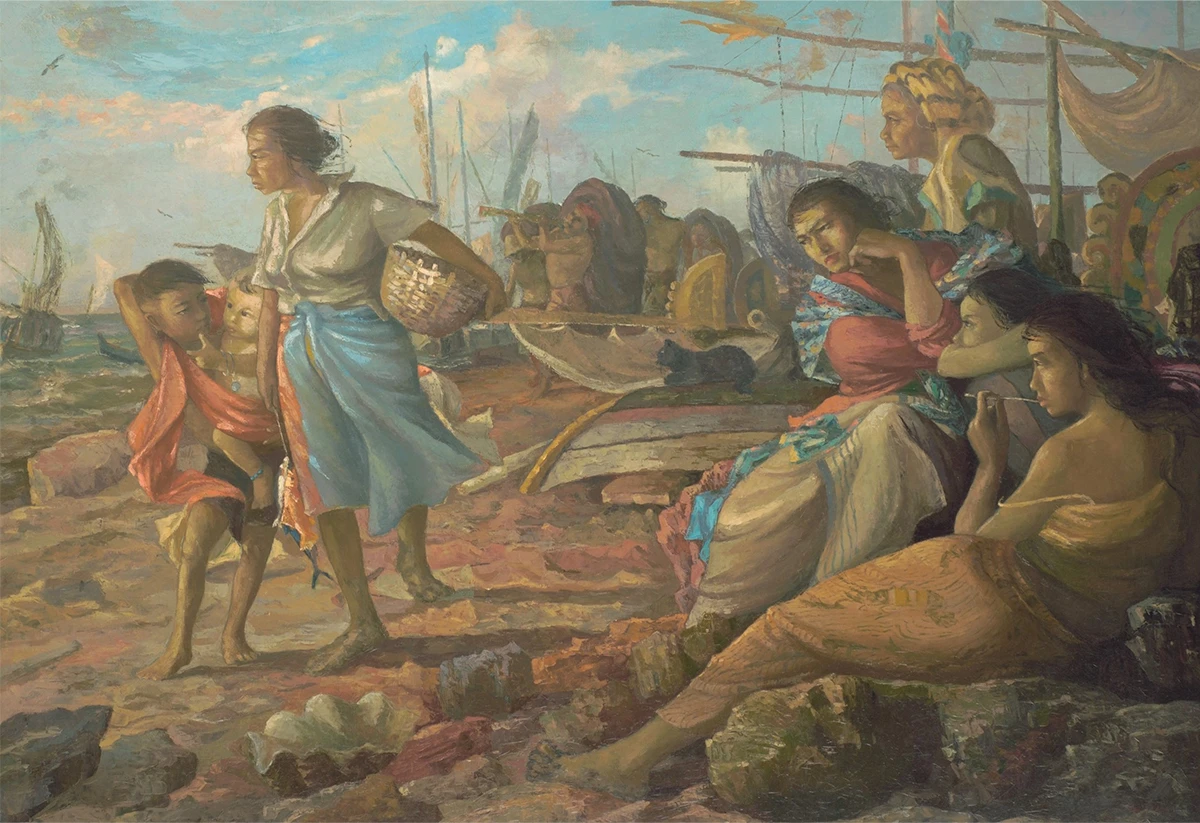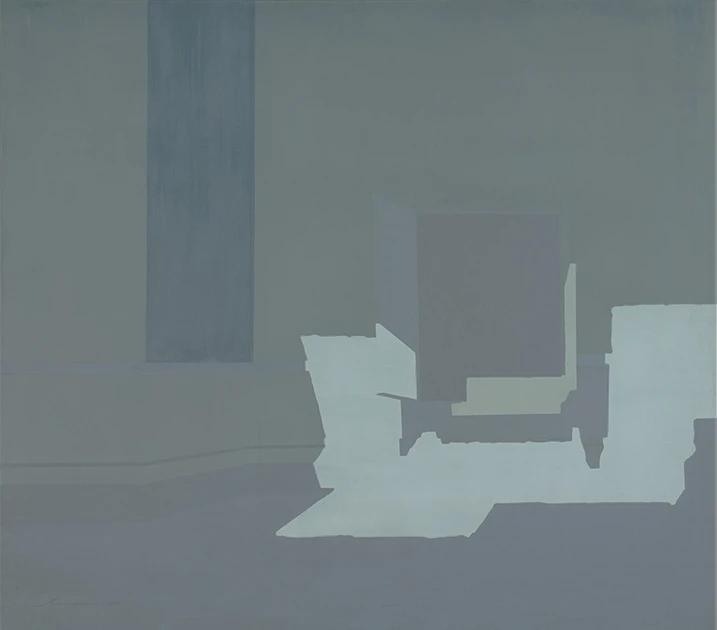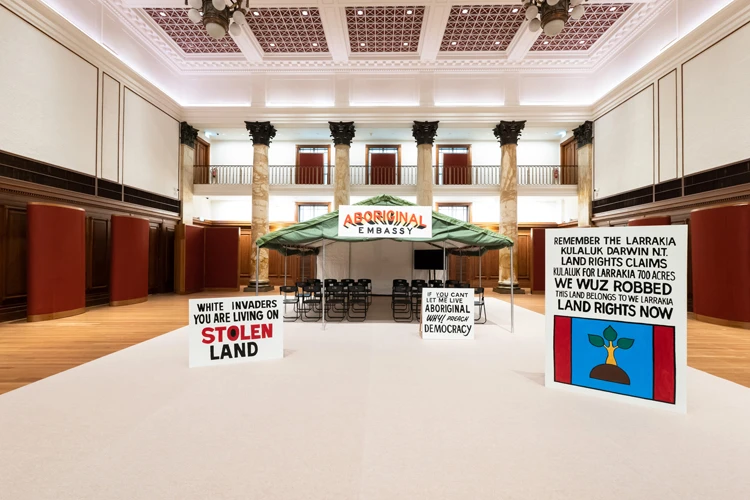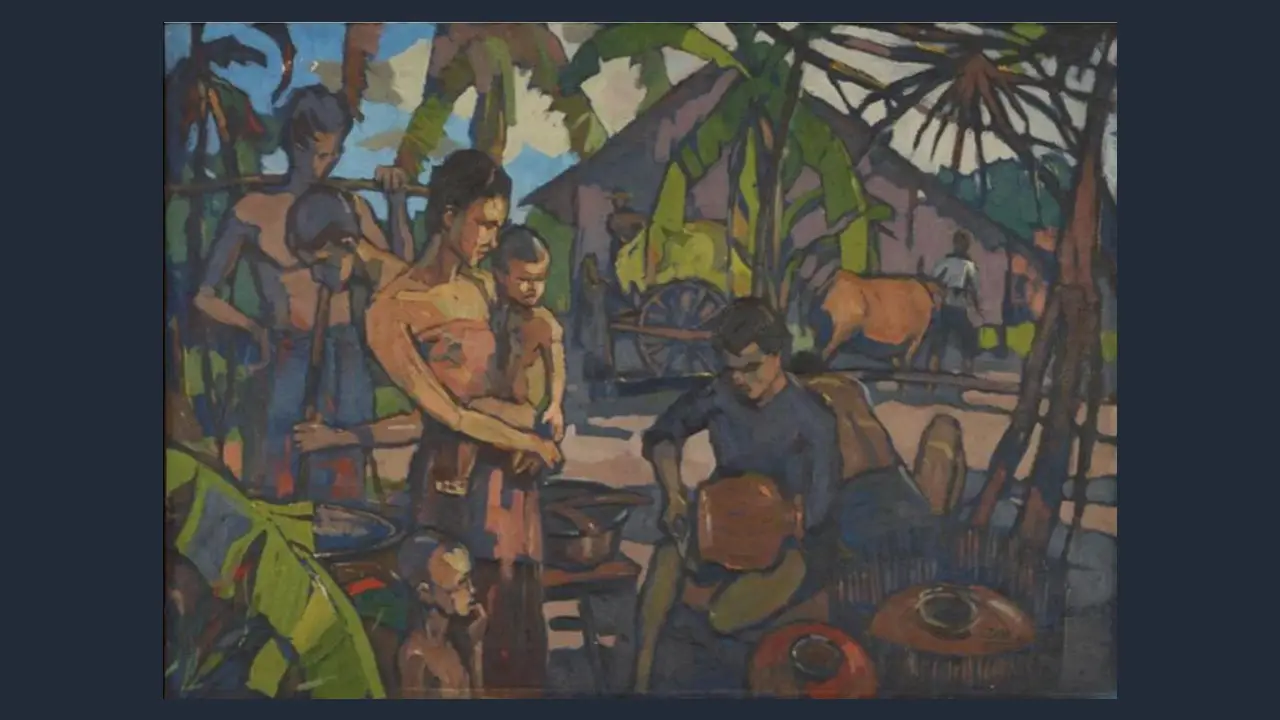Itji Tarmizi: The Missing Link
Indonesian social realist artist Itji Tarmizi and his contemporaries are known as a “missing link” in Indonesia’s modern art history as little is known about their work. Gerald Sim (Intern, Curatorial and Research) digs deeper into Menyongsong Fajar (Watching the Sunrise), Itji’s monumental work of social realism, to unearth more about the artist and the time in which he lived and worked.

Menyongsong Fajar
(Watching the Sunrise), c. 1950s–1965
Oil on canvas
132.5 x 191.5 cm
Collection of National Gallery Singapore
Exhibited in UOB Southeast Asia Gallery 6 of the Gallery’s long-term display Between Declarations and Dreams: Art of Southeast Asia since the 19th Century, Menyongsong Fajar (Watching the Sunrise) is a monumental work of social realism by the Indonesian artist Itji Tarmizi. A group of women of varying ages sit on a rock outcropping, welcoming the dawn on a coast filled with boats and fishing equipment. The central figure in the painting is a woman in mid-stride, holding a basket in one hand and a fish in the other while her child trails alongside her.
It is likely that Itji produced this work when he was part of Sanggar Bumi Tarung (Battling Earth Studio), an informal studio in which artists lived and worked communally, sharing proceeds and costs equally amongst themselves. It was a central tenet of the ethos of turba (an abbreviation of turun ke bawah, which means “to descend below”) that its members “eat, sleep, and work” alongside the peasant communities they lived amongst. In Indonesia, social realism refers to art designed to embolden people’s struggle for better conditions and reflect their realities. The members eschewed the idealised depictions of the working class typical of socialist realism from Russia and China and did not shy away from depicting class antagonisms as they really were.
One of Itji’s finest paintings, Lelang Ikan (Fish Auction), is in the collection of former Indonesian president Sukarno. Under Sukarno’s patronage and with the nation still reeling from post-independence revolutionary furore, social realism enjoyed widespread acclaim. Lekra (Lembaga Kebudayaan Rakyat, Institute of People’s Culture), the parent organisation of Sanggar Bumi Tarung, aligned itself with Sukarno’s conception of Indonesian democracy. Sukarno himself was present at the first Lekra National Congress held in Solo in 1959. Sukarno’s presidential collection, a canonical collection of Indonesian art of that time, is largely composed of social realist works by Lekra artists.
The installation of the New Order regime by succeeding president Suharto in 1965 brought about sweeping changes to politics, which permeated the culture realm. Lekra was banned due to its affiliation with the Indonesian Communist Party. As a branch organisation of Lekra, the Sanggar Bumi Tarung was naturally dissolved as well. Its members were violently persecuted, and those who were not went into hiding.
Itji himself escaped to his birth village of Batu Sangkar, West Sumatra. Already an enigmatic figure, he faded into obscurity while art preferences in Indonesia under the New Order underwent a major shift. The concept of the “people” espoused by Lekra, associated with the now-persecuted left, took a back seat. Instead, abstraction was favoured because of its associations with the West, supposed international and universal orientation, and apolitical nature.
Itji and his social realist contemporaries are known as a “missing link” in Indonesia’s modern art history. They form the important, politically-charged bridge between the first stirrings of modernity with the founding of PERSAGI (Persatuan Ahli-Ahli Gambar Indonesia, Union of Indonesian Drawers, an important union in the development of modern art in Indonesia) and the rise of abstraction under the New Order regime. Most works by Itji and his peers are in the hands of private collectors, and documentation of this period of Indonesian art history is scant. Much of Lekra’s cultural production has been dismissed as sterile or uninteresting propaganda, but there is much to be gleaned from the works of this period.
Menyongsong Fajar (Watching the Sunrise) in particular proves to be a valuable record of the prevailing social conditions of the time. It foregrounds the industry of women, whose representations in Indonesian art left much to be desired up to this point. It depicts the working class and fishing communities of what is likely to be East Java, a recurring image in Itji’s paintings. The tense and serious facial expressions of the subjects remind us of the anxiety that pervaded the young republic then. The word “menyongsong” in the title can also be interpreted as “to go up against”; to oppose a force. One wonders if Itji’s choice of words is meant to remind his viewers of the revolutionary zeal that fuels his works.
Perhaps we will never know. If Itji said anything about his artworks, it was hardly documented. Art historian Agus Dermawan T once recounted how the artist protested the renaming of his work Melawan Kenaikan Harga (Against Price Hikes) to Lelang Ikan (Fish Auction), which is a far less political title. That Itji was vocal about the matter demonstrates his firm resolve in the political content of his works. While the title of the painting was briefly changed for an exhibition in 2015, after 2017 its title was reinstated as Lelang Ikan again.
Itji died in 2001, shortly after his only solo exhibition in Jakarta. In my research into the artist, I found that the accompanying materials from this exhibition have yet to be located. It is said that he left behind a chest of paintings for to his nephew, but when said chest was opened, it was empty. There is still much to be discovered about Itji Tarmizi, and perhaps more works of art that now exist only in our imagination.
References and Further Reading
On Sanggar Bumi Tarung and Lekra, information is drawn from Prof. Dr. M. Agus Burhan, M.Hum. Seni Lukis Indonesia Masa Jepang Sampai Lekra (Indonesian Painting from the Japanese Occupation to LEKRA.) Surakarta: Dwi – Quantum, 2013.
On the anecdote on Itji Tarmizi, information is drawn from Agus Dermawan T. Dari Lorong-lorong Istana Presiden (From the Corridors of the Palace.) Jakarta: Kepustakaan Populer Gramedia, 2019.
On the role of Lekra in Indonesian art, information is drawn from Foulcher, Keith. "Politics and Literature in Independent Indonesia: The View from the Left", Asian Journal of Social Science 15, 1 (1987): 83-103, doi: https://doi.org/10.1163/080382487X00073
On the various art movements, including PERSAGI, Lekra, and Sanggar Bumi Tarung, information is drawn from Cribb, R. B., and Audrey Kahin. Historical Dictionary of Indonesia. 2nd ed. Historical Dictionaries of Asia, Oceania, and the Middle East, no. 51. Lanham, Md: Scarecrow Press, 2004.








-min 1.png)



